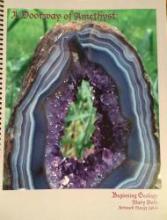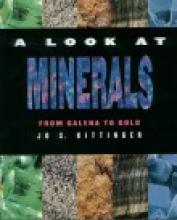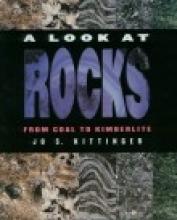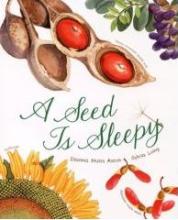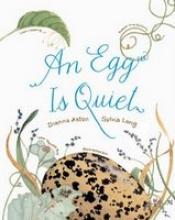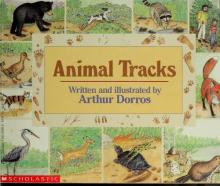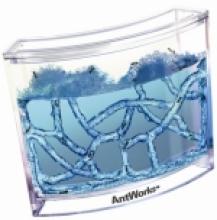Science
A Doorway of Amethyst
Here is a geology text that assumes no conflict between Christianity and science and is faithful to Church teaching. This book covers basic topics in geology, including the Earth's age and composition, the dynamics of continental plate motion, classification of rocks and soil, effects of glaciers, radiometric dating, and more. The illustrations are lovely and hand-drawn – not what you would expect in a textbook. However, I prefer a few glossy photographs as well, but you can find these on the internet. I was unfamiliar with many of the geologic terms so I learned a lot along side my 12-year-old daughter. I especially appreciated the author's explanation of evolution in the appendix and Chapter 11 on the geologic column in the Williston Basin.
I allotted 18 weeks to finish this book, but it took 22 weeks, rushing a bit. The book has suggested research activities at the end of most chapters, but we did not do very many of them. (I had already ”planned” one semester of chemistry to follow one semester of geology.) The last chapter consists of short biographies of mostly Catholic scientists. There is also a suggested reading list at the end of the book. Exercises are included at the end of each chapter - lots of crosswords, matching, fill-in-the-blank, multiple choice, etc. There are also poems interspersed throughout the text to aid in memorization. If we had done more research activities and added supplemental reading, this book would expanded into a full-year course. There were no tests included so it was necessary to make some to reinforce the material.
Mary Daly mostly separates scientific considerations from philosophical ones. She sticks her opinions in the appendices. However, the one exception is in the first chapter when she explains charitably that Young Earth Creationism is inconsistent with scientific evidence.
Here are some of the ideas (as far as I can understand) that really distinguish this book from most geology texts aimed at the home school market:
- The text is consistent with our Catholic Faith.
- Radiometric dating of rocks shows that the Earth is about 4.5 billion years old.
- While we are all descended from two first parents, the fossil record points to a single "family tree of life" of which we are a part.
- Evolution of new species by natural selection is an incomplete explanation of the fossil record. In an appendix, the author suggests that additional mechanism is needed to account for the sudden appearance of new species in the fossil record. John Davison, a professor of zoology, developed a semi-meiotic hypothesis as just this sort of mechanism. I found this very intriguing since it is compatible with what is observed and is testable. Mary Daly also suggests that some paleontologists have a philosophical bias that prevents them from considering other scientific explanations.
- The geologic record does not support a worldwide flood. Mary Daly explains there is not enough water on Earth to do this. She suggests that Noah's flood was probably a catastrophic flood that affected the part of the world known to the inspired writer.
Overall, I think A Doorway of Amethyst is a very good, well-written geology text. I am grateful that Mary Daly took the time to write it. I recommend it and plan to use it again. Next time, I would want to write cumulative quizzes for each chapter, allow more time for supplemental reading, and incorporate more projects and writing assignments. (I can dream, anyway.)
You can view sample pages at the end of this document on the author's Hedge School website.
This is a 1st edition of the text, and my daughter found quite a few typographical errors in it.
Reviewed by Pam Blakeslee
A Look at Minerals
A surprisingly interesting (and fairly in-depth) picture book that introduces children to minerals - which include metals and gems. Many full color photos highlight and enhance the text, which covers topics such as Mohs' Scale of Mineral Hardness, ice crystals, cleavage planes (the way minerals break when cut) of various minerals, metals in their natural state, special metals like gold, silver and platinum, how various minerals form and what they look like in their natural state. My children and I found this to be quite an interesting book.
A Look at Rocks
I really didn't expect to get much out of a children's picture book on rocks. Rocks are, well, rocks! I was wrong. Mrs. Kittinger has done a fine job in presenting various types of rock, how they are formed in nature (with a significant emphasis on volcanoes) and the various fascinating and often beautiful varieties of rocks. There are many stunning photos and fascinating statistics on rock-related items from Mount Rushmore (and it's lesser known "sister-sculpture" - Stone Mountain - of some "monumental" figures of the Confederacy) to the Grand Canyon to amazing volcano formations. The book also includes a glossary, an index, suggestions for further reading and internet resources for rock collectors.
A Seed is Sleepy
An Egg is Quiet
Animal Tracks
One of the things that fascinates me most about Wisconsin winters (I grew up in California) are the animal tracks clearly visible in the snow. It leaves a temporary record of what was visiting while you weren't looking – what a fascinating thing for homeschoolers to look into. Animal Tracks will make a nice resource for younger students to study local wildlife. This is an illustrated narrative of animal life with a little guessing game on each page based on the tracks left by each animal. The book also contains four pages of identified tracks (including humans) and instructions for "preserving" the tracks with plaster of paris or by tracing. An excellent way to spark children's interest in nature.
AntWorks Ant Habitat
AntWorks was one of the highlights of our summer natural history studies! This simple kit became a quirky centerpiece on our dinner table, engaging the entire family from the 18-month-old who insists that they are "Nants" to a 40-something daddy. AntWorks comes as a thick-walled plastic home with a stable base; this became important as the little ones spent time watching the ants. We have tried the sand-filled ant farms with dismal spills that freed too many of the inhabitants. The AntWorks home is filled with a blue gel-like substance that provides both nourishment and liquid to the ants. Accompanying literature explains that this gel was developed by NASA for experiments carried out on the Space Shuttle. One of the nicest features is that this gel is translucent, allowing observers to see completely through the tunnels. An optional illuminator is a nice addition which makes an interesting night light, but we thought that it wasn't necessary.
Ants are not included with the kit. You can either catch your own or mail in the enclosed coupon. We opted for the mail-order ants, and that boosted interest in the project for our little ones who love to receive mail. Once the ants are added to their home, the only maintenance that is needed is opening the top for a few seconds a week to allow fresh air to enter. Occasionally you will need to remove a dead ant, but our industrious insects buried their fallen comrades deep in the gel in sealed chambers. It was incredible to observe! This kit, combined with a few books from the library and a couple of diagrams and coloring pages downloaded from the Internet, provided a wonderful investigation into the life of ants for our elementary school-aged students.
Science Kit, Dimensions: 6.5"L x 5.5"W x 1.25"D

